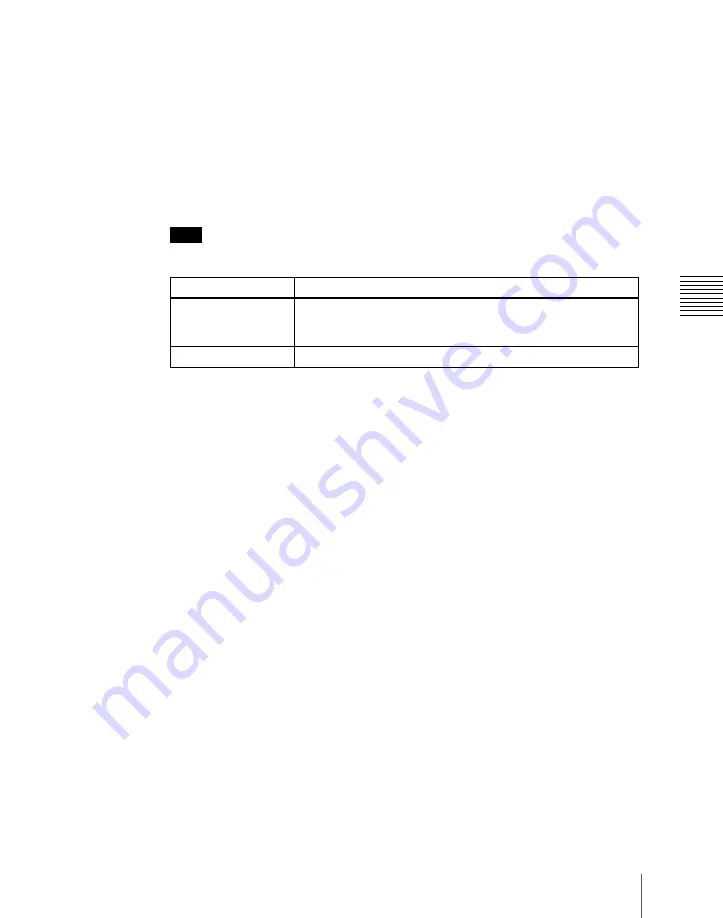
315
Overview
Chap
In three-channel mode, a brick appears over the old video as the image is
expanding and rotating, and switches to the new video.
(Pattern number: 3601 (three-channel mode))
User programmable DME:
Using a DME keyframe effect created with a
keyframe operation, this executes a DME wipe.
(Pattern numbers: 1901 to 1999 (one-channel mode), 2901 to 2999 (two-
channel mode), 3901 to 3999 (three-channel mode))
For details of creating keyframe effects, see “Creating User
Programmable DME Patterns” (page 340).
Note
In an independent key transition, the following patterns can be used.
User programmable DME in transition mode
For the transition mode set when creating a keyframe effect for a user
programmable DME pattern, the following can be used.
•
Single:
single transition mode
•
Flip tumble (Flip Tumble):
flip tumble transition mode
•
Dual:
dual transition mode
•
Picture-in-picture (PinP):
one-channel and two-channel picture-in-picture
transition mode
•
Compress:
a type of picture-in-picture, in which the new image is the
background, and the currently visible image shrinks, and then expands to its
original size. (See example in the next item.)
•
Frame in-out (Frame I/O):
frame in-out transition mode. When the first
transition completes, if you move the position of the image, you can move it
both horizontally and vertically.
•
Frame in-out H (Frame I/O H):
a type of frame in-out mode, which is
specified when creating a transition effect in the horizontal direction.
The image movement is reflected at both the transition start point and end
point.
(See
The operation is carried out according to DME wipe patterns 1202, 1203, or
1204.
•
Frame in-out V (Frame I/O V):
a type of frame in-out mode, which is
specified when creating a transition effect in the vertical direction.
The image movement is reflected at both the transition start point and end
point.
(See
Execution mode
DME wipe patterns that can be used
One-channel mode
Slide, split, squeeze, door, 2D trans, 3D trans, frame in-out,
page turn, page roll, mirror, sphere, character trail, wave, ripple,
split slide, sparkle, user programmable DME
Two-channel mode
Page turn, page roll
Summary of Contents for DVS-9000
Page 44: ...44 Setup Chapter 1 DVS 9000 Functions ...
Page 136: ...136 Basic Menu Operations Chapter 2 Menus and Control Panel ...
Page 310: ...310 Wipe Pattern Operations in the Multifunction Flexi Pad Control Block Chapter 5 Wipes ...
Page 440: ...Chapter 9 Color Corrector 440 Color Corrector Functions ...
Page 441: ...Chapter 10 Special Functions Simple P P Software 442 Overview 442 Restrictions on Use 442 ...
Page 446: ...Engineering Setup Menu 484 Diagnostic Menu 488 ...
Page 448: ...Appendix Volume 1 448 Wipe Pattern List Enhanced Wipes 26 27 29 49 300 301 302 303 304 ...
Page 452: ...Appendix Volume 1 452 Wipe Pattern List Random Diamond Dust Wipes 270 271 272 273 274 ...
Page 490: ...DVS 9000 9000SF System SY 3 704 906 11 1 2002 Sony Corporation ...
Page 782: ...Chapter 13 Keyframe Effects 782 Register Operations in the Menus ...
Page 816: ...Chapter 14 Snapshots 816 Snapshot Operations in the Menus ...
Page 838: ...Chapter 15 Utility Shotbox 838 Shotbox Register Editing ...
Page 840: ...Macro Timeline 910 Creating and Editing a Macro Timeline 912 ...
Page 914: ...914 Macro Timeline Chapter 16 Macros ...
Page 945: ...945 SpotLighting Appendix Volume 2 Shape Patterns 1 2 ...
Page 972: ...DVS 9000 9000SF System SY 3 704 906 11 1 2002 Sony Corporation ...
Page 1010: ...Chapter 18 System Setup System 1010 System Maintenance Maintenance Menu ...
Page 1164: ...Chapter 22 DCU Setup DCU 1164 Serial Port Settings Serial Port Assign Menu ...
Page 1190: ...Chapter 25 DIAGNOSIS 1190 Checking the Communications Status ...
Page 1228: ...DVS 9000 9000SF System SY 3 704 906 11 1 2002 Sony Corporation ...
















































